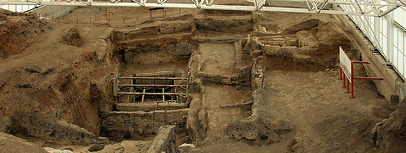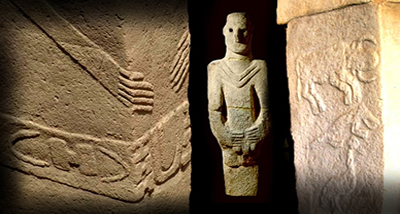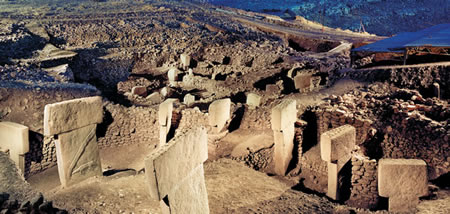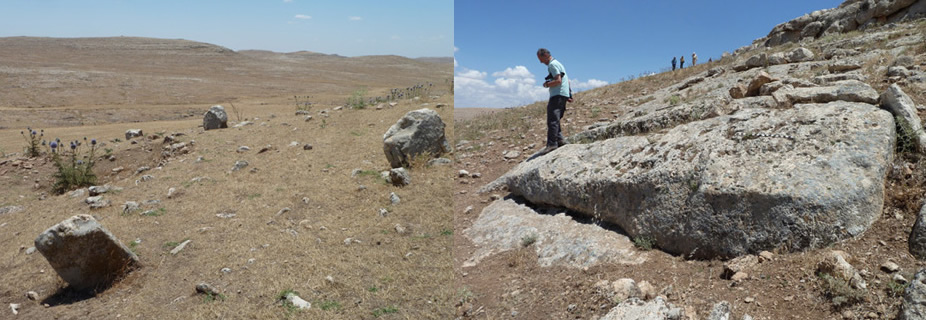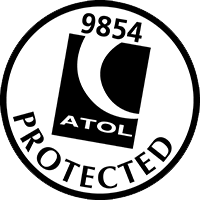| Megalithomania and Andrew Collins presents
GOBEKLI TEPE & ANCIENT TURKEY TOUR October 13th - 23rd 2018 (11 days) Hosted by Andrew Collins, author of Gobekli Tepe: Genesis of the Gods, with Megalithomaniac Hugh Newman, author of Earth Grids and Stone Circles, and special guest from the USA, Jj Ainsworth, a leading authority on ancient symbolism. There will be 30 spaces for this exclusive tour. Currently 9 spaces are available. An extension after the tour to Baalbek and Lebanon is from 23rd - 27th October. Details below.
The breath-taking plains and steppes of eastern Turkey, the traditional Garden of Eden or terrestrial Paradise, was the setting for the Neolithic revolution and the rise of civilization. We will visit some of the world’s most exciting archaeological sites including Göbekli Tepe, the oldest stone temple complex and now a World Heritage Site, and Karahan Tepe, an unexcavated site from the same era. The new Urfa Archaeological museum has hundreds of artefacts from Gobekli Tepe, Nevali Çori and other pre-pottery neolithic sites. We also explore the ancient city of Harran, and Çatal Höyük, the world’s first city. We visit the city of Konya, home of the Whirling Dervishes; Alaca Hoyuk and Hattusa that have incredible megalithic polygonal masonry similar to Peru, Sanliurfa, the ancient Christian city of Edessa, birthplace of Abraham; and the traditional area of the Garden of Eden, home of the Watchers and Nephilim of the book of Enoch, and the Annunaki of Sumerian myth and legend. We will also visit two of the huge underground cities - Derinkiyu and Kaymakli, as well as the Fairy Chimneys of Cappadocia. Andrew, Hugh and Jj will be presenting evening lectures throughout the tour, plus they will be discussing theories and new research on site.
|
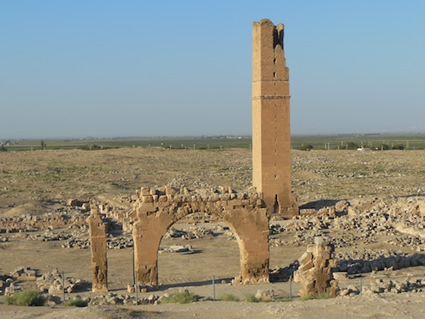 The stunning ruins of the Paradise Mosque, with the mighty Astronomical tower, Harran. |
Inside the beautiful beehive markets in Harran, where you can get beautiful hand crafted clothes and gifts. |
Day 9 - Sunday October 21st
Visit Urfa Archaeological Museum to see display of compelling exhibition of artefacts from Göbekli Tepe, including the mysterious bone plaque with an artistic image of Gobekli Tepe discovered on our tour in September 2015, pictured below (see video here). We also see a full size reconstruction of the original site on display.
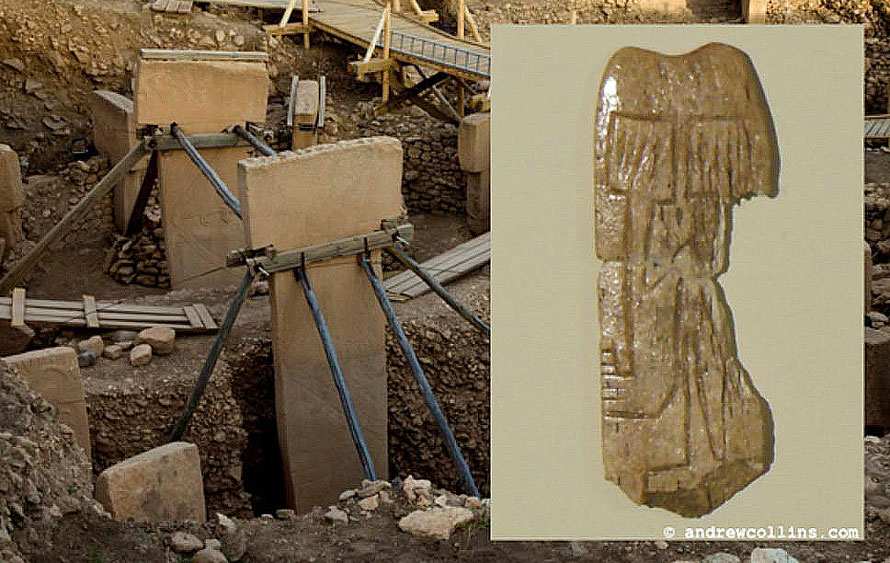
One of the most important parts of the museum is the Nevali Çori reconstruction, that was completly transported stone by stone from its original location to the museum. Also on display is the famous carved head with a Vedic looking serpent on the back of the head. See the Megalithomania film about the site below, that includes a visit to its original location, that has now been completely flooded by the Ataturk Dam.
We will also visit Nimrod’s Castle, the Pools of Abraham, and the birthplace of the great prophet. Urfa (a.k.a. Sanliurfa, “the prophet’s city”, or Edessa in ancient times) is the most spiritual city in East Turkey. It is a major centre for pilgrimage and its traditions are very much alive and well. The “Sanli-“ part of its name (meaning “great” or “dignified”) was awarded by the Turkish legislature in 1984 in recognition of the city’s pivotal role in the Turkish war of Independence. Of particular note for visitors are Urfa castle (the current walls were constructed by the Abbasids in 814AD), the Pool of Sacred Fish where Abraham was thrown into the fire by Nimrod, the park of mosques, the market area and Urfa museum. After lunch we shall visit Gobekli Tepe (second visit) in the late afternoon to get a real taste of this incredible site with time for meditation and freedom to explore the site alone. B-D
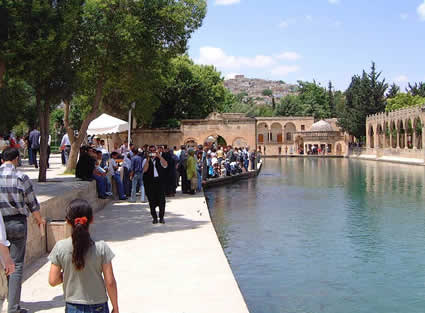 |
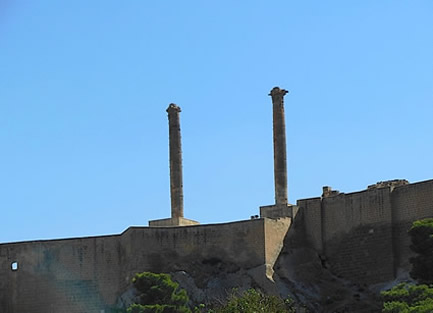 |
Day 10 - Monday October 22nd
Early evening visit to Nemrut Dagi (Nimrod’s Mountain), but on the way stop at Karakus Timulus and Cendere Bridge. Cendere Bridge is one of the world’s oldest bridges still to be in use, constructed during the empire of Septimus Severus. Composed of 92 stones, each weighing around 10 tons, it is thought to be the second largest Roman bridge still in existence, spanning an impressive 122 metres. The bridge today appears as a simple, unadorned arch, but was originally decorated by four Corinthian columns dedicated to Septimus Severus and his wife.Mount Nemrut is the site of the original Tower of Babel and Mountain of God of biblical tradition. Gaze out over the terrestrial Paradise as enjoyed by the biblical patriarchs of the book of Genesis that is the perfect place to experience a sunrise or sunset. One of East Turkey’s most spell-binding attractions at the peak of this mountain (at over 2000m) sit enigmatic statues of a pre-Roman king, Antiochus I Theos of Commagene, and the various gods he believed to be his ancestors. The views from the summit are sublime. (NOTE it is a 20-30 minute walk up steps to reach the summit). Farewell Dinner. Meals: B, D
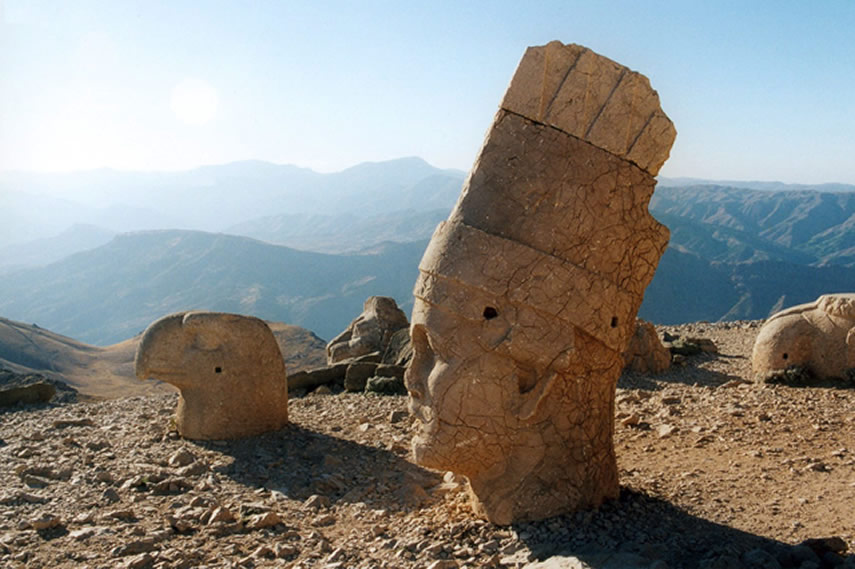
Day 11 - Tuesday October 23rd
Optional trip to Mount Nemrut for sunrise with additional cost for people who want to join. After breakfast travel to Adiyaman airport. Fly back to Istanbul for completion of tour. B (flight included).
Baalbek and Lebanon Add-On
October 23rd - 27th
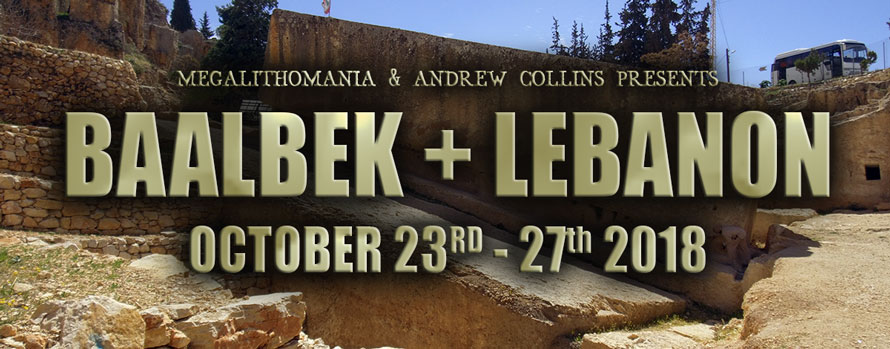
Lebanon Tour Costs: |
Day 1: Tuesday October 23rd
Arrival day in Beirut and transport to the hotel. If you are part of the Turkey tour we arrive in Beirut at 10.15pm from Istanbul at the Beirut–Rafic Hariri International Airport. You will be welcomed by a representative and guide. Transport to Warwick Palm Beach Hotel.
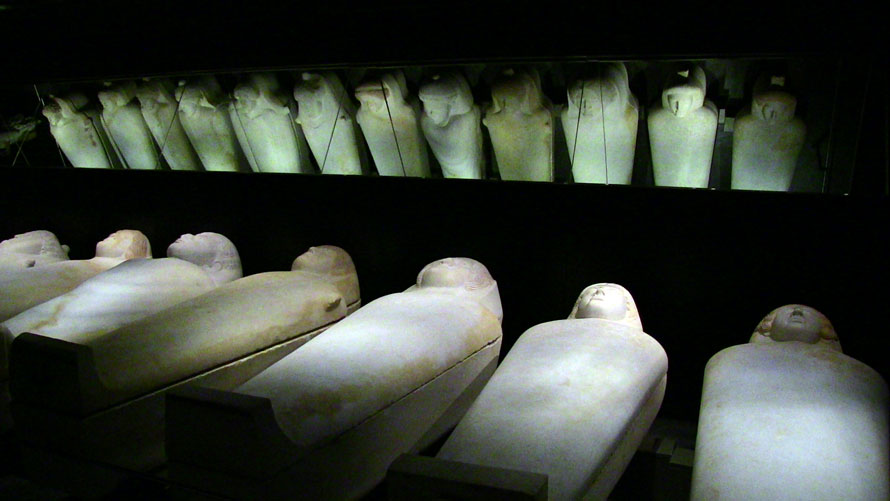
Day 2: Wednesday October 24th
Lebanon National Museum is filled with many fascinating artifacts, including many that are clearly Egyptian. We will also explore Jeita Grotto, paleolithic caves that are an incredible sight to behold. After lunch we continue to Byblos, the beautiful Phoenician city. Byblos is a true microcosm of the civilizations that have populated Lebanon over the millenia. Arguably believed to be one of the oldest continuously inhabited cities in the world, the modern port city of Byblos is built upon multiple layers of ruins, dating back to as early as the Stone Age and extending to the more recent Ottoman days. Andrew and Hugh have examined much evidence that displays an obvious timeline of megalithic construction with distinct connections to both ancient Egyptian and Anatolian cultures.- Overnight Warwick Palm Beach Hotel, B, L
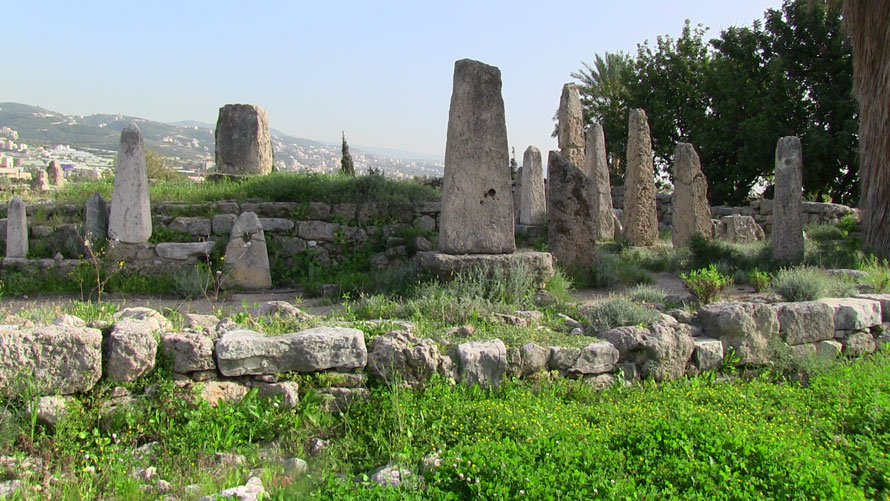
Day 3: Thursday October 25th
Drive to Baalbek. Two hour drive. Visit the Baalbek Quarry that contains the 'Stone of the Pregnant Woman' estimated to weight 1000 tons. In 2014 a much larger monolith was discovered weighing in at 1650 tons that is now excavated. We will look at the folklore of giants who may have been involved in the construction of the main Baalbek Temple that is about 1000m away. Hugh will also share his research on the idea that it was deliberately left there to mark the birthplace of the temple. How could they have moved such large stones uphill to the main temple in antiquity? Did the Romans really do this or was it a much earlier culture.
We will also explore the western quarry at Baalbek that contains the the 1240 ton monolith and a private quarry with elaborately carved caves that have not been documented before. Overnight Grand Kadri in Zahleh, B, L
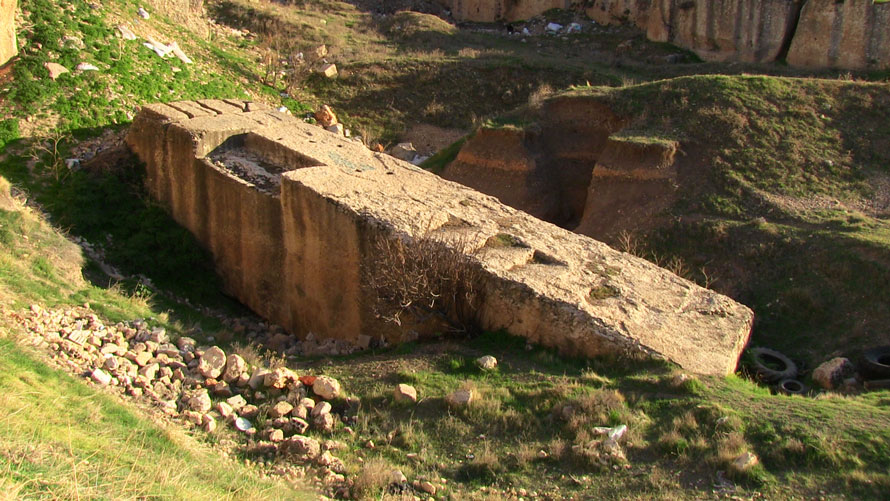
Day 4: Friday October 26th
Full day at Baalbek Temple. Known as Heliopolis or the “City of the Sun” during Greco-Roman times, the site of Ba’albek shows much evidence that a more advanced civilization must have built and inhabited the area thousands of years earlier. The western wall has several stones weighing between 400 and 800 tons, with many more outrageously large stones in various parts of the temple. We will see the six remaining Corinthian columns of the Jupiter Temple, made from rose granite, transported all the way from the Aswan Quarries in Egypt. Eight more were disassembled and shipped to Constantinople under Justinian’s orders circa 532-537 CE, for his basilica of Hagia Sophia. Overnight Grand Kadri in Zahleh, B, L
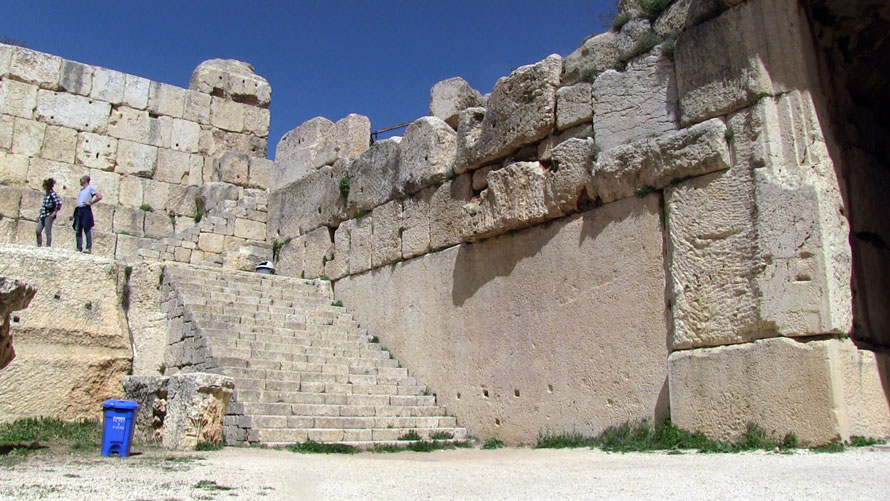
Day 5: Saturday October 27th
After Breakfast we leave for an exploration of Anjar, formerly known as Gerrha, a stronghold built by Umayyad Caliph Al-Walid ibn Abdel Malek in the 8th century. The actual construction was undertaken by laborers from Anatolia and Coptic artisans from Egypt. It was founded on a strategic location between Baalbek and Damascus. Umayyad Caliph Walid I started its construction in 714. The city was never completed, and destroyed and abandoned already in 744. The layout of Anjar was heavily influenced by Roman planning. Two meter thick walls contained the 114,000 square-meter city. It had forty towers and a gate. The city held over 600 shops, a Roman grid, a monumental tetrapyle, the Umayyad Palace, a mosque and a hammam. Afterwards, we’ll drive to the famous Wine Caves and complete our tour with complimentary wine tasting and lunch. back to Beirut. Please plan for your International flight home after 4 PM or plan to spend another night in Beirut. B, L
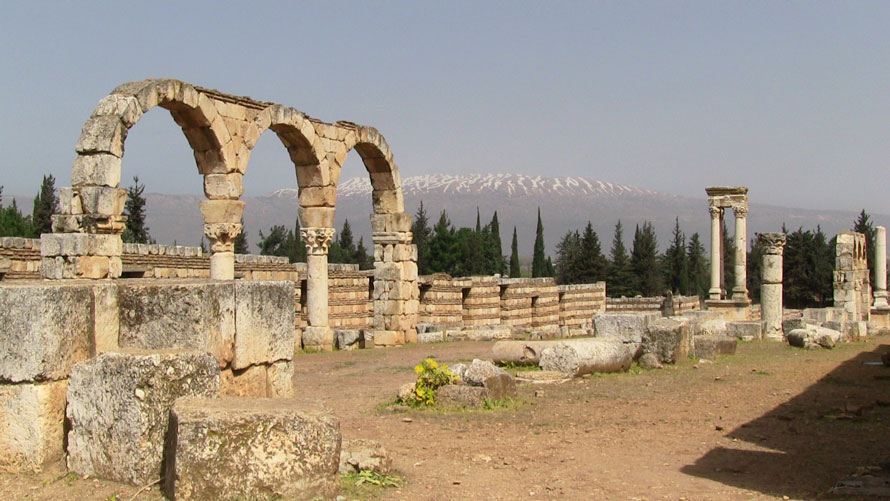
Itinerary subject to change due to circumstances beyond our control.
Price includes Price does not include |
|
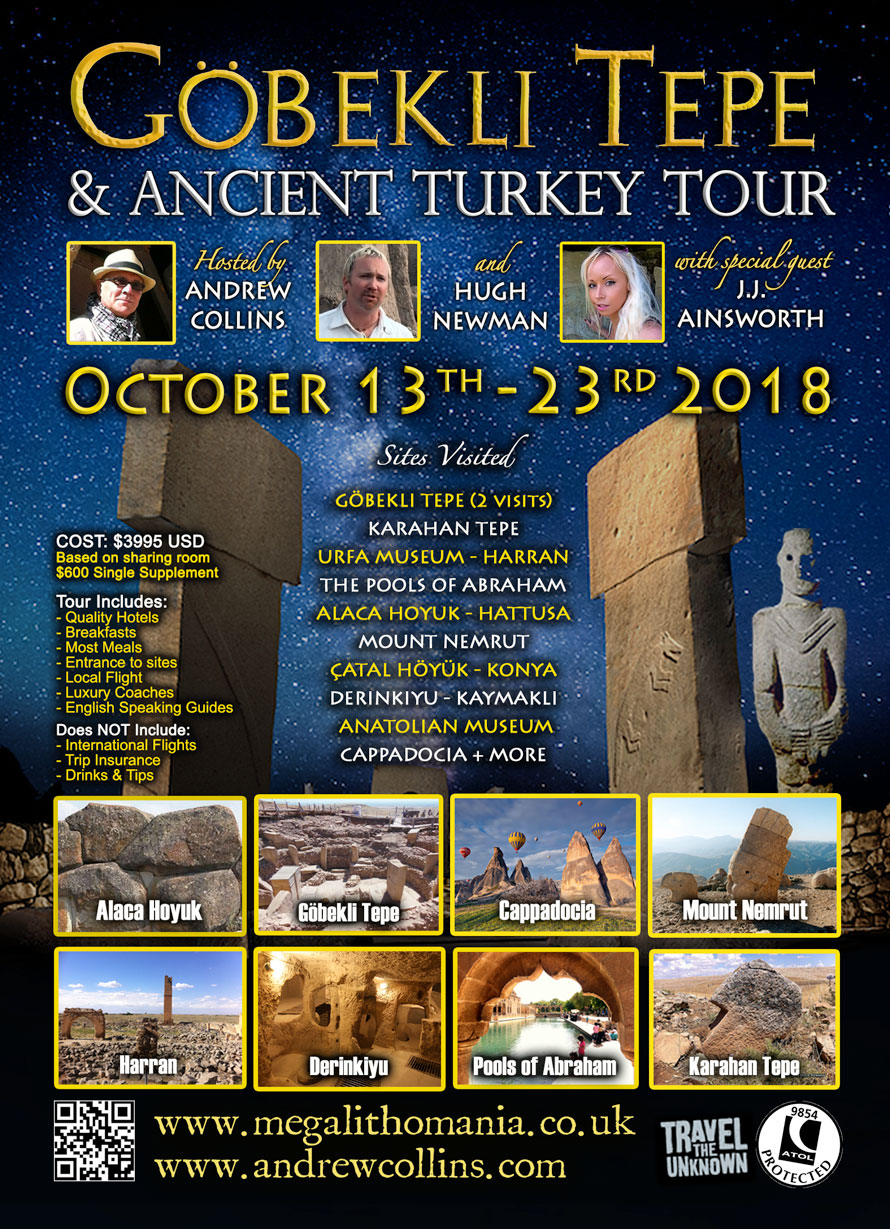
Feedback from 'Origins of Civilization' Turkey Tour 2013 with guest host Graham Hancock

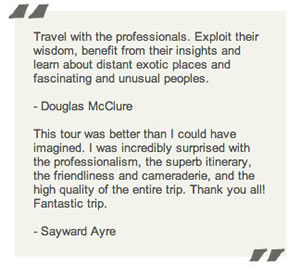 "It was a great trip"- Graham and Santha Hancock, UK
"It was a great trip"- Graham and Santha Hancock, UK
"It was a fabulous journey with the best of company!" - Anu Nagappa, India
"What a fabulous trip - one which we will be integrating into our minds for some time."
- Terry Fitzsimmons, USA
"Thanks for a great Megalithomaniac Tour! The whole group gelled together with a great positive energy in this wonderful adventure."
- Robert David, USA
"Had a great though exhausting time on the tour. It was wonderful to meet Graham and Santha and hear his lectures, also to have the opportunity to share Andrew's passion for and knowledge of so much of interest to me. Others on the tour were very interesting and such good company - it's so good to travel with like-minded souls. So impressed with Arda' efficiency and patience!! It was all really well organised and I'm sure everyone enjoyed it all." - Christine Levy, Australia
Feedback from 'Gobekli Tepe Mini-Tour' in September 2015
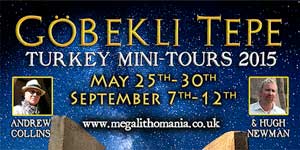
"Pat and I loved the Tour. We've never done anything like that before."
- Harold White, USA
"Thank you Hugh and Andrew for a fabulous tour. The thing i liked best was the quality time we got at Gobeki Tepe and with each of you sharing your extensive knowledge. It warmed my heart to see how utterly enthralled Andrew is with Gobekli Tepe e as if he had lived there in a prior life and was coming home. It is one thing to enjoy and appreciate a historical site, but Andrew is in rapture. And his enthusiasm enhanced my appreciation too. My sister and I look forward to another tour with your team."
-
Colleen McGuire, USA
"Fantastic trip! Well organized with great guides and an fun group."
- Bob Patterson, USA
"Many thanks to You and Andrew for a great trip."
- Anthony Deleo, USA
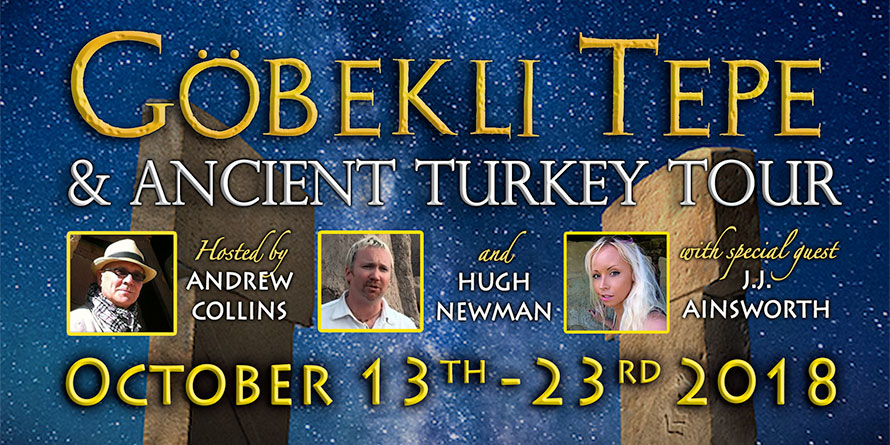

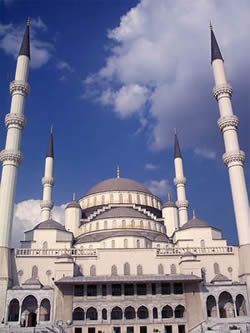 Proposed Itinerary: subject to change
Proposed Itinerary: subject to change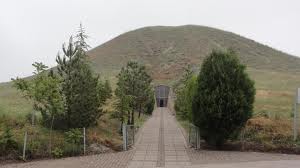 After breakfast visit Anatolian Civilization Museum of Ankara , and see artefacts and reconstructions from Neolithic sites such as Catal Hoyuk. Lunch in Ankara. After lunch drive to Gordion (The tumulus of King Midas). Excavated in 1957, the mound of Midas is 300 meters in diameter and is 43 meters high. In the wooden chamber, the corpse of a man was found along with the remains of his last dinner. It still contains some furniture, presumably from Midas` palace. We may see several other mounds en-route to the hotel in Hattusa. Evening presentation by one of the speakers. B-L-D
After breakfast visit Anatolian Civilization Museum of Ankara , and see artefacts and reconstructions from Neolithic sites such as Catal Hoyuk. Lunch in Ankara. After lunch drive to Gordion (The tumulus of King Midas). Excavated in 1957, the mound of Midas is 300 meters in diameter and is 43 meters high. In the wooden chamber, the corpse of a man was found along with the remains of his last dinner. It still contains some furniture, presumably from Midas` palace. We may see several other mounds en-route to the hotel in Hattusa. Evening presentation by one of the speakers. B-L-D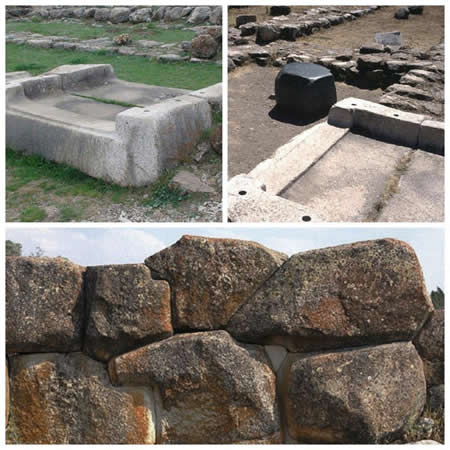 Visit the Hittite capital of Hattusa, c. 1800-1200 BC. See rock cut inscriptions and reliefs of warriors and Hittite gods in the rock sanctuary. Visit the massive city walls, Sphinx entrances, polygonal walls and polished green nephrite naval stone in the Great Temple dating from the age of the Hittite Empire (time for meditation at site). Hattusa was once the centre of the Hittite Empire, dating back to the late Bronze Age. Set in what were once rich agricultural fields and among scenic, rolling hills, the city has some fine examples of early ancient architecture. Originally the inner city was a vast array of temples and monuments, overlooked by the royal residence on the acropolis. An architectural masterpiece in its time, the city gateway was once adorned with reliefs of warriors, lions and sphinxes, framing four temples, each of which had their own courtyard. The city was destroyed, along with the Hittites themselves, in the 12th century BC. By the 20th century, the principal remains of Hittite inscriptions were found on over 10,000 tablets. Lunch in Hattusa. After lunch journey on to the magnificent ruins of Alaca Hoyuk, a Hittite city with origins dating back to the Chalcolithic or Copper Age. Visit the museum, and see the extraordinary polygonal walls, like those in Peru, Easter Island and ancient Egypt. We had the pleasure of showing author Graham Hancock the site in September 2013, and you can watch the film of that exploration below. Drive to Cappadocia, arriving at your hotel in Göreme, for a late dinner. B-L-D.
Visit the Hittite capital of Hattusa, c. 1800-1200 BC. See rock cut inscriptions and reliefs of warriors and Hittite gods in the rock sanctuary. Visit the massive city walls, Sphinx entrances, polygonal walls and polished green nephrite naval stone in the Great Temple dating from the age of the Hittite Empire (time for meditation at site). Hattusa was once the centre of the Hittite Empire, dating back to the late Bronze Age. Set in what were once rich agricultural fields and among scenic, rolling hills, the city has some fine examples of early ancient architecture. Originally the inner city was a vast array of temples and monuments, overlooked by the royal residence on the acropolis. An architectural masterpiece in its time, the city gateway was once adorned with reliefs of warriors, lions and sphinxes, framing four temples, each of which had their own courtyard. The city was destroyed, along with the Hittites themselves, in the 12th century BC. By the 20th century, the principal remains of Hittite inscriptions were found on over 10,000 tablets. Lunch in Hattusa. After lunch journey on to the magnificent ruins of Alaca Hoyuk, a Hittite city with origins dating back to the Chalcolithic or Copper Age. Visit the museum, and see the extraordinary polygonal walls, like those in Peru, Easter Island and ancient Egypt. We had the pleasure of showing author Graham Hancock the site in September 2013, and you can watch the film of that exploration below. Drive to Cappadocia, arriving at your hotel in Göreme, for a late dinner. B-L-D.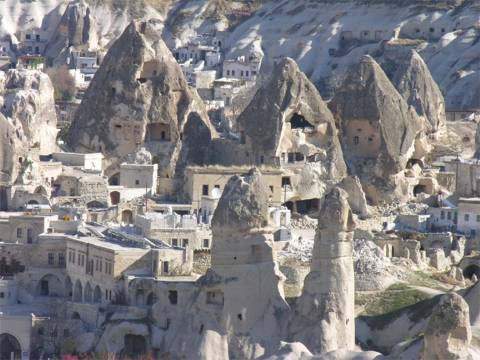 hundred people. As well as chapels, stables and storage, an efficient man-made system of air shafts provided ventilation even at the deepest levels of the underground cities so they were able to survive there for lengths of time when necessary. The people of Kaymakli village have constructed their houses above nearly one hundred tunnels of the underground city. The inhabitants of the region still use the most convenient places in the tunnels as cellars, storage areas and stables, which they access through their courtyards. Ortahisar is another Cappadocian village dominated by a fortress-like rock rising above winding roads. The 90m high natural fortress in Ortahisar has partly crumbled away revealing some of its interior. Today it has been restored and the peak is accessible by a staircase. The Ortahisar Castle offers a magnificent panorama over the fairy chimneys of Hallacdere and the snowy peak of Mt. Erciyes. Lunch. Visit Uchisar natural castle and finally Goreme open air museum, capital of Turkey’s eastern province of Cappadocia, with its lunar landscape dominated by conical rock towers known as Fairy Chimneys. See Goreme’s rock-cut churches, with their strange art with its origins in the prehistoric age. Devrent Valley is home to the famous Fairy Chimneys near Goreme and is known as the imaginary valley or animal valley due to the animal shapes in rocks. While Fairy
hundred people. As well as chapels, stables and storage, an efficient man-made system of air shafts provided ventilation even at the deepest levels of the underground cities so they were able to survive there for lengths of time when necessary. The people of Kaymakli village have constructed their houses above nearly one hundred tunnels of the underground city. The inhabitants of the region still use the most convenient places in the tunnels as cellars, storage areas and stables, which they access through their courtyards. Ortahisar is another Cappadocian village dominated by a fortress-like rock rising above winding roads. The 90m high natural fortress in Ortahisar has partly crumbled away revealing some of its interior. Today it has been restored and the peak is accessible by a staircase. The Ortahisar Castle offers a magnificent panorama over the fairy chimneys of Hallacdere and the snowy peak of Mt. Erciyes. Lunch. Visit Uchisar natural castle and finally Goreme open air museum, capital of Turkey’s eastern province of Cappadocia, with its lunar landscape dominated by conical rock towers known as Fairy Chimneys. See Goreme’s rock-cut churches, with their strange art with its origins in the prehistoric age. Devrent Valley is home to the famous Fairy Chimneys near Goreme and is known as the imaginary valley or animal valley due to the animal shapes in rocks. While Fairy 